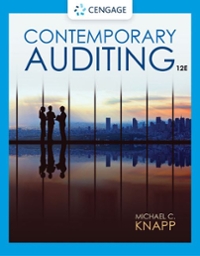Bankrate's management organized the company into three operating divisions: Core, Insurance, and Credit Cards. The Core division
Question:
Bankrate's management organized the company into three operating divisions: Core, Insurance, and Credit Cards. The Core division housed the company's original operations that provided mortgage interest rate data to U.S. consumers as well as available interest rates for certificates of deposit, money market accounts, and other interest-bearing accounts. Consumers could obtain competitive quotes for a wide range of insurance products from Bankrate's Insurance division, including automotive, health-care, and life insurance policies. Finally, the company's Credit Cards division provided consumers with information regarding specific features-such as fees and available reward programs- of credit cards offered by banks and other financial institutions. Collectively, Bankrate's websites supplied consumers with online access to information for the financial products of almost 5,000 banks, insurance companies, and other financial services providers.
In 2015, Bankrate reported that it collected and posted to its websites on a weekly basis, more than three million data items and that those websites received more than five million visits each week from Internet users. At the time, the company produced revenue from two primary sources: payments for "leads" (referrals) that it delivered to its customers-the banks, insurance companies, and other entities whose product information was posted on Bankrate's websites-and the sale of display advertising on its websites.
A group of Bankrate stockholders sued the company in 2013 for supposedly embellishing its potential leads revenue when it went public in June 2011. "Bankrate executives allegedly told investors that [the company] could get higher referral fees and be more profitable than its competitors."1 The plaintiffs charged that such statements caused the company's stock price to rise from the $15 per share IPO price in June 2011 to nearly $25 per share in March 2012. The stock price subsequently declined to
less than $17 per share in May 2012 after company officials revealed that Bankrate's leads revenue was not meeting their expectations.
In August 2014, Bankrate settled the class-action lawsuit by agreeing to pay the disgruntled stockholders $18 million. One month later, Bankrate issued a press release revealing that it was the subject of an investigation by the Securities and Exchange Commission (SEC). That investigation was focusing on Bankrate's reported operating results for the second quarter of 2012. At the same time, Bankrate revealed that Edward J. DeMaria, the company's chief financial officer (CFO), had resigned from that position although he was remaining with the company in another capacity.
Questions
1. Are auditors responsible for searching for fraud while "reviewing" a public company's quarterly financial statements? Explain. If so, what specific fraud risk factors should the Grant Thornton auditors have considered while performing their review of Bankrate's financial statements for the second quarter of 2012?
2. Define the phrase "earnings management" and distinguish between earnings management and fraudulent accounting. Under what circumstances, if any, is it acceptable for corporate executives to employ earnings management tactics? Explain.
3. What are the key factors that should be considered in determining whether a financial statement amount is "material"? Should auditors apply the same materiality guidelines or benchmarks as financial accountants? Defend your answer.
4. Identify the primary audit objectives for an accrued liability account, such as Bankrate's SEM accrual. What circumstances relevant to accrued liabilities, can prove to be particularly challenging for auditors?
5. Assuming that the SEC's allegations are true, the parties principally responsible for the Bankrate fraud were DiMaria, Gamsey, and Lerner. What other parties bear some degree of responsibility for the fraud? Defend your answer.
Step by Step Answer:






